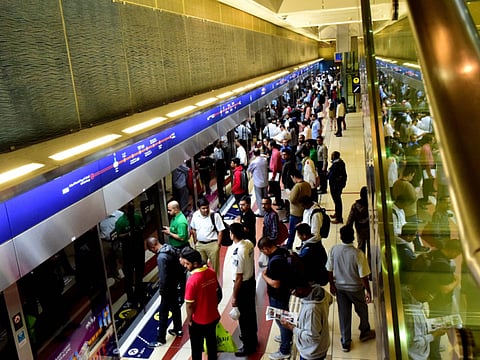RTA studies short trip proposal for Dubai Metro to ease congestion during peak hours
More than 31,000 people use the metro per hour early in the morning, in the evenings it goes up to 53,000

Dubai: Metro commuters facing daily rush hour blues could get some relief if the Roads and Transport Authority (RTA) implements short trips between busy stations, which are currently under study.
Dubai Metro’s immense popularity has led to crowding of the trains, particularly during morning and evening peak hours, with many commuters complaining it is difficult to set a foot inside the trains during rush hours.
According to Mohammad Al Mudharreb, director of rail operations at RTA’s Rail Agency, the authority is looking at various options to tackle peak hour congestion and one of the options under study is the short loop.
“The RTA is studying the implementation of the ‘Short Loop’ where service for certain trains will terminate a few stops before Jebel Ali (UAE Exchange Station) and return towards Rashidiya. This should be an effective solution in controlling passenger numbers and ease overcrowding,” Al Mudharreb said.
More than 31,000 people use the metro per hour early in the morning, while the evening congestion is reflected by the ridership figure of 53,000 per hour.
The morning rush hours are from 7am to 9am and the evening peak hours are from 4.30pm to 8pm.
Currently, RTA operates 71 trains during peak hours, 54 on the red line and 17 on the green line. During peak hours, the trains run at a frequency of 2 min 38 seconds on the red line and every five minutes on the green line.
Off peak, the trains run at a headway of six to eight minutes on the red line and seven to eight minutes on the green line.
RTA is planning to increase the number of trains for the Route 2020 project and that process is being expedited due to the current urgency.
“We are procuring the additional trains for the Route 2020 Project and the process is already on fast track. Apart from this, we are also studying other immediate alternatives such as implementing short loop,” Al Mudharreb said.
The congestion forces a lot of commuters to miss their stations as they can’t dodge their way out of trains.
“More trains should be operated during peak hours as the current number is not sufficient. Sometimes it becomes suffocating as too many people are cramped and even getting off the train at your desired station becomes difficult,” said Mohammad Nayeem, a regular commuter.
Another regular commuter said he is forced to skip trains almost daily during evening rush hours.
“I catch the train at around 6pm daily from Noor Bank station, but to catch the train I have to let go at least three to four trains, before I can squeeze myself in. At least what RTA can do is increase the stop duration during peak hours, so that people have enough time to embark and disembark,” Naufil Mustafa said.
Trains stop for 30 seconds at Burjuman and 20 seconds at Union stations (red line) and at rest of the stations stoppage duration is between 15 to 10 seconds.
On the green line, trains stop for 30 seconds at Burjuman and Union and 15 seconds at rest of the stations. Union and Burjuman are two of the busiest stations on either lines.
RTA’s director of Rail Operations said the service frequency can be improved only when new trains are procured.
“RTA has an established process for improving services. As per the process, RTA regularly monitors the services through dynamic data and site visits and improves the services,” Al Mudharreb added.
Metro popularity has seen continued growth in ridership, with the current daily average ridership standing at 512,152, registering a six per cent growth over last year. The red line carries 324,507 passengers daily while the green line transports 187,645 people each day.
Sign up for the Daily Briefing
Get the latest news and updates straight to your inbox

